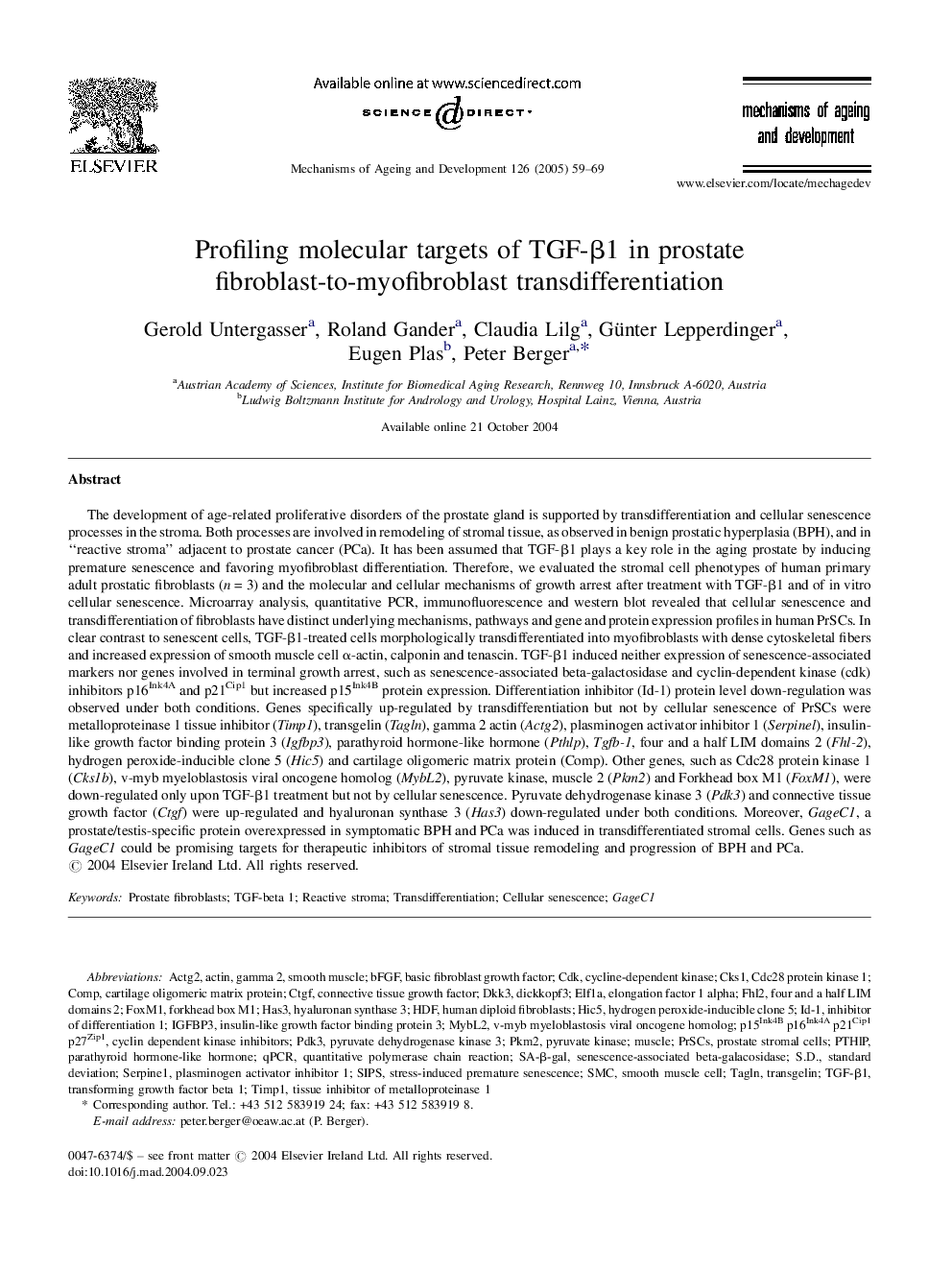| Article ID | Journal | Published Year | Pages | File Type |
|---|---|---|---|---|
| 9881382 | Mechanisms of Ageing and Development | 2005 | 11 Pages |
Abstract
The development of age-related proliferative disorders of the prostate gland is supported by transdifferentiation and cellular senescence processes in the stroma. Both processes are involved in remodeling of stromal tissue, as observed in benign prostatic hyperplasia (BPH), and in “reactive stroma” adjacent to prostate cancer (PCa). It has been assumed that TGF-β1 plays a key role in the aging prostate by inducing premature senescence and favoring myofibroblast differentiation. Therefore, we evaluated the stromal cell phenotypes of human primary adult prostatic fibroblasts (n = 3) and the molecular and cellular mechanisms of growth arrest after treatment with TGF-β1 and of in vitro cellular senescence. Microarray analysis, quantitative PCR, immunofluorescence and western blot revealed that cellular senescence and transdifferentiation of fibroblasts have distinct underlying mechanisms, pathways and gene and protein expression profiles in human PrSCs. In clear contrast to senescent cells, TGF-β1-treated cells morphologically transdifferentiated into myofibroblasts with dense cytoskeletal fibers and increased expression of smooth muscle cell α-actin, calponin and tenascin. TGF-β1 induced neither expression of senescence-associated markers nor genes involved in terminal growth arrest, such as senescence-associated beta-galactosidase and cyclin-dependent kinase (cdk) inhibitors p16Ink4A and p21Cip1 but increased p15Ink4B protein expression. Differentiation inhibitor (Id-1) protein level down-regulation was observed under both conditions. Genes specifically up-regulated by transdifferentiation but not by cellular senescence of PrSCs were metalloproteinase 1 tissue inhibitor (Timp1), transgelin (Tagln), gamma 2 actin (Actg2), plasminogen activator inhibitor 1 (Serpinel), insulin-like growth factor binding protein 3 (Igfbp3), parathyroid hormone-like hormone (Pthlp), Tgfb-1, four and a half LIM domains 2 (Fhl-2), hydrogen peroxide-inducible clone 5 (Hic5) and cartilage oligomeric matrix protein (Comp). Other genes, such as Cdc28 protein kinase 1 (Cks1b), v-myb myeloblastosis viral oncogene homolog (MybL2), pyruvate kinase, muscle 2 (Pkm2) and Forkhead box M1 (FoxM1), were down-regulated only upon TGF-β1 treatment but not by cellular senescence. Pyruvate dehydrogenase kinase 3 (Pdk3) and connective tissue growth factor (Ctgf) were up-regulated and hyaluronan synthase 3 (Has3) down-regulated under both conditions. Moreover, GageC1, a prostate/testis-specific protein overexpressed in symptomatic BPH and PCa was induced in transdifferentiated stromal cells. Genes such as GageC1 could be promising targets for therapeutic inhibitors of stromal tissue remodeling and progression of BPH and PCa.
Keywords
TIMP1SA-β-galFOXM1FHL2CKS1DKK3IGFBP3SERPINE1COMPTGF-β1PKM2ACTG2MYBL2TAGLNId-1HAS3TGF-beta 1four and a half LIM domains 2CTGFCDKqPCRSMCHDFbFGFS.D.Reactive stromastandard deviationtransforming growth factor beta 1TransgelinTransdifferentiationforkhead box M1Smooth muscle cellSipselongation factor 1 alphaMuscleConnective tissue growth factorbasic fibroblast growth factorHuman diploid fibroblastsTissue inhibitor of metalloproteinase 1plasminogen activator inhibitor 1cyclin dependent kinase inhibitorsquantitative polymerase chain reactionInsulin-like growth factor binding protein 3Cartilage oligomeric matrix proteinpyruvate kinaseStress-induced premature senescenceCellular senescence
Related Topics
Life Sciences
Biochemistry, Genetics and Molecular Biology
Ageing
Authors
Gerold Untergasser, Roland Gander, Claudia Lilg, Günter Lepperdinger, Eugen Plas, Peter Berger,
